Remembering to remember the World Trade Center

This essay is excerpted from David Knowles’s “Remembering to Remember the World Trade Center.” The full version is available on Kindle and can be purchased here from Amazon.
At approximately 8:50 a.m. on Tuesday, Sept. 11, 2001, I was pushing a stroller carrying Eli, my 2-year-old son, toward the Borough Hall subway station in downtown Brooklyn. My wife, Jennifer, was already teaching her ethics class at Baruch College in Manhattan, and I was in charge of taking Eli to his daycare center at the City University of New York, which was located on Fifth Avenue, two blocks north of the Empire State Building. The ride on the N train usually took half an hour, and the route passed underneath the World Trade Center at what was then the Cortlandt Street station.
Eli had already begun memorizing the stops along the way between Borough Hall and 34th Street, and liked to ride in the front car so that he could look out the front window from the vantage point of the subway motorman. Another of my son’s quirks was that he tended to anthropomorphize tall buildings. “Hello, Empire State Building,” “Hello, World Trade Center,” he would say whenever we were walking in Manhattan or on the Brooklyn Heights Promenade and he caught sight of the distinctive architectural markers that topped the structures. For that reason, Cortlandt Street held special resonance, which he’d sometimes note when he announced our arrival as though he were the actual conductor: “This is Cortlandt Street station, World Trade Center.”

As Eli and I approached the Borough Hall subway entrance, I was struck by the number of people gathered at a street corner, looking up in the direction of lower Manhattan. When I asked what was going on, a woman told me a plane had hit the twin towers. From her slightly impatient tone — that eye-rolling “what now?” attitude that is so common among New Yorkers — I assumed the crash must have been an accident. There was a faint cloud of smoke in the air, but it was such a warm, sunny day that it was almost impossible to imagine anything might ruin it. The Brooklyn skyline obscured a view of the World Trade Center, and with cellphone technology still limited to phone calls and texts, visuals of what had happened weren’t instantly available.
I continued on to the station, where I encountered another odd sight: commuters bounding up the steps, frantically heading the opposite direction of the usual rush hour pattern. “There’s smoke on the platform,” a man told me as I bent down to lift the stroller. “It’s closed. No more trains.” For a moment, I considered taking another line into Manhattan, still not able to process the information and unwilling to be inconvenienced. But I couldn’t help wonder if the smoke in the sky and on the subway platform might somehow be linked. If I walked six blocks to the F train, would it be closed too? As if on cue, the winds changed and gray, wispy strands of smoke began encroaching on Brooklyn. I wheeled the stroller around and headed back to our apartment, hearing more voices in the groups of people congregated at each corner talking about the plane. “Not a Cessna” as I had first imagined, but “a jet” a “passenger jet.”
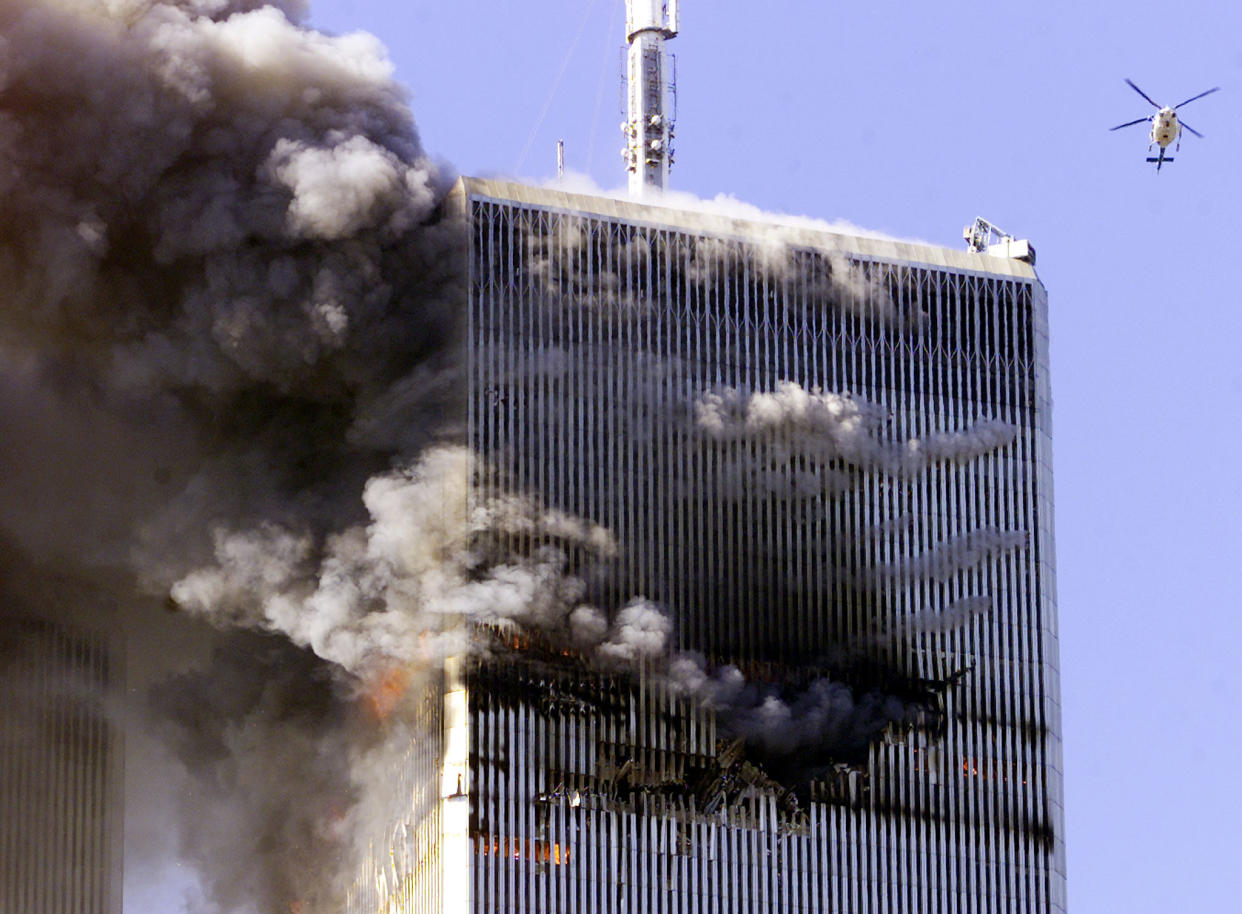
Back at our building, my son and I took the elevator up to the roof deck on the 15th floor. I parked the stroller and carried him outside, where we got our first look at the World Trade Center’s burning north tower, its rigid geometry absurdly topped by a chaotic bloom of smoke erupting into the blue sky. How are they ever going to put out a fire that high up? I remember thinking. Helicopters were circling, and sirens from approaching trucks echoed from all directions. After a few minutes, I decided there wasn’t much more to see so we went down to our apartment, and I turned on the television and began calling friends only to hit busy signals. Eli started playing with blocks. Then, as I watched it live on television, the second plane hit the south tower, making it obvious: This was an act of terrorism.

I picked Eli up and we headed back up to the roof, where I snapped two photos on my new digital camera of what seemed like a firefighter’s ultimate nightmare. I would have taken more, but I realized that dozens, perhaps hundreds of people must have died or were still dying in the attack. It felt wrong to watch the disaster unfold as a tourist. Even then, the worst my mind could conjure was that the floors the planes had mangled and those above it would burn, imperiling those still trapped inside, while those below would be spared. I envisioned an elaborate rescue mission. Hundreds of helicopter flights to pluck survivors from the roof. Hungry for more information, I went back downstairs and turned on the television while Eli continued stacking his blocks.
By this time, video of United Airlines Flight 175 slamming into the south tower was being played in a loop on every television station. News crews had arrived at the World Trade Center minutes after the first plane made impact and were in position to capture the second, providing multiple angles and vantage points, each more astonishing than the last.
Eli had nearly finished with his own twin towers and needed help placing the last few blocks, as they were taller than his reach. When we were done, he went to his room and returned with a die-cast airplane, and he began flying it in the air near his skyscrapers. Building and destroying towers was a regular game my wife and I played with him, but this was the first time an airplane had been introduced.
“What did the pilot say when he crashed into the World Trade Center?” he asked me suddenly.
My eyes filled with tears. “I don’t know,” I replied. “I don’t know.”
“Did he say I’m sorry?” Eli asked.
I pulled him close and hugged him and shut off the television. Visible from our window, brown smoke had begun to envelop the building.
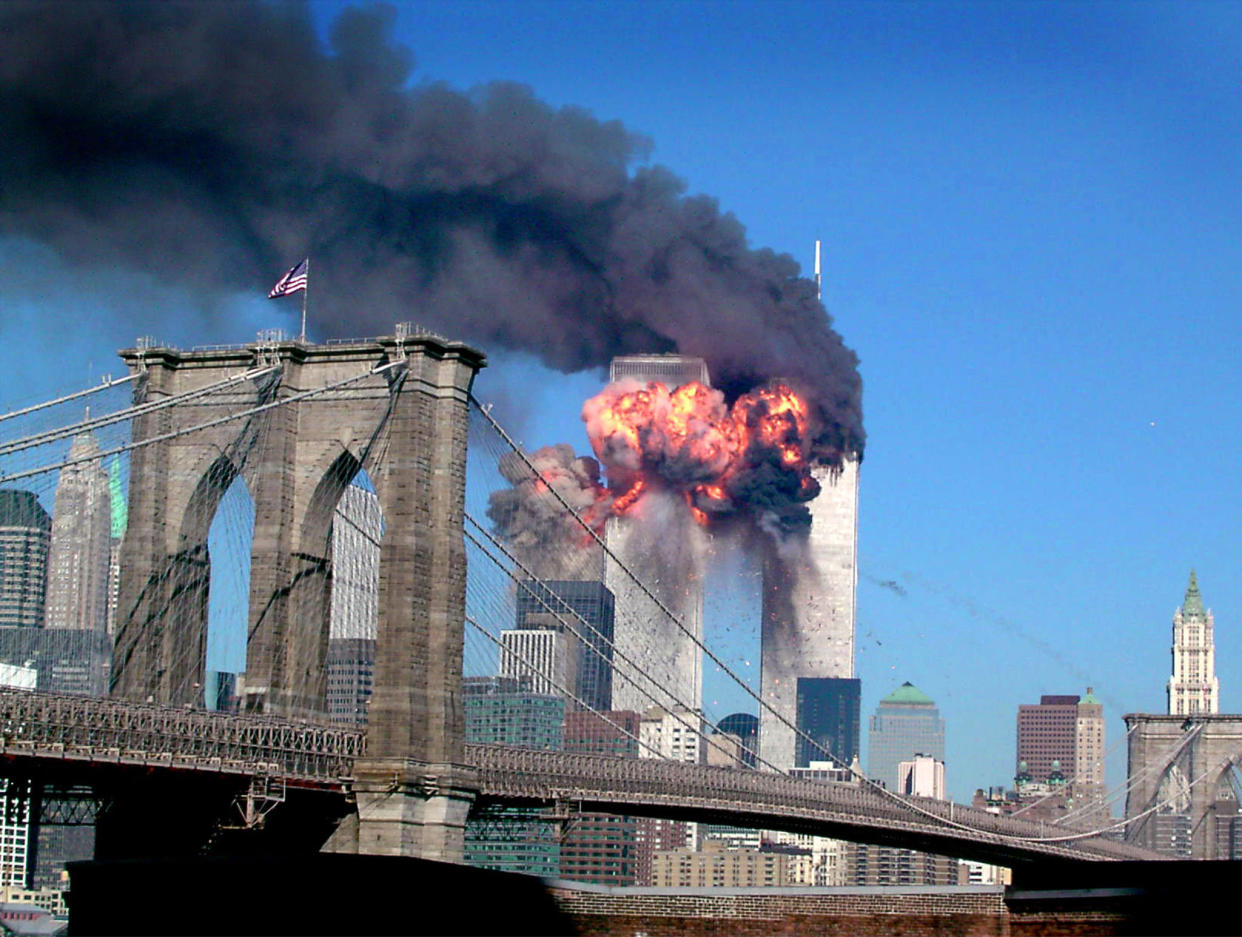
Every New Yorker who lived through that day 20 years ago has a story to tell about it — where they were, what they saw. Though my wife taught straight through the towers falling, her ethics class was briefly interrupted when a stranger — perhaps a student at Baruch — opened the door and yelled in “A plane just hit the World Trade Center!” The outburst elicited shrugs because everyone, including my wife, envisioned a Cessna accident. When she emerged into the shaken world and entered the philosophy office, however, she immediately sensed something was amiss. No one was smiling or talking. “Is everything OK?” she asked the department secretary.
“You haven’t heard?” she replied. “The World Trade Center just fell down.”
Disbelief quickly turned to terror. Were Eli and I safe? Where was the N train when the towers fell? She convinced the secretary to let her use the phone, her hands shaking as she dialed. Luckily, she got through on the first try and put those fears to rest.

A few hours later, New York real estate developer and television personality Donald Trump was recounting his own 9/11 story in an interview with a local news station. “I mean 40 Wall St. was the second-tallest building in downtown Manhattan and it was — actually before the World Trade Center — it was the tallest, and then, when they built the World Trade Center, it became known as the second-tallest,” Trump explained, omitting the existence of an even taller lower Manhattan skyscraper at 70 Pine St. “Now it’s the tallest.”
Fear of heights
Why do people climb mountains? Because they are there. Why do people build skyscrapers? Because they aren’t.
The standout feature of the twin towers, of course, was their height. When they were completed in 1973, they were celebrated as the world’s tallest buildings, but the race to the sky did not end with them. In subsequent years, much taller structures have been built, and it’s one measure of how we have moved on from the disaster that if the World Trade Center was still standing today, it would rank as the 34th-tallest skyscraper.
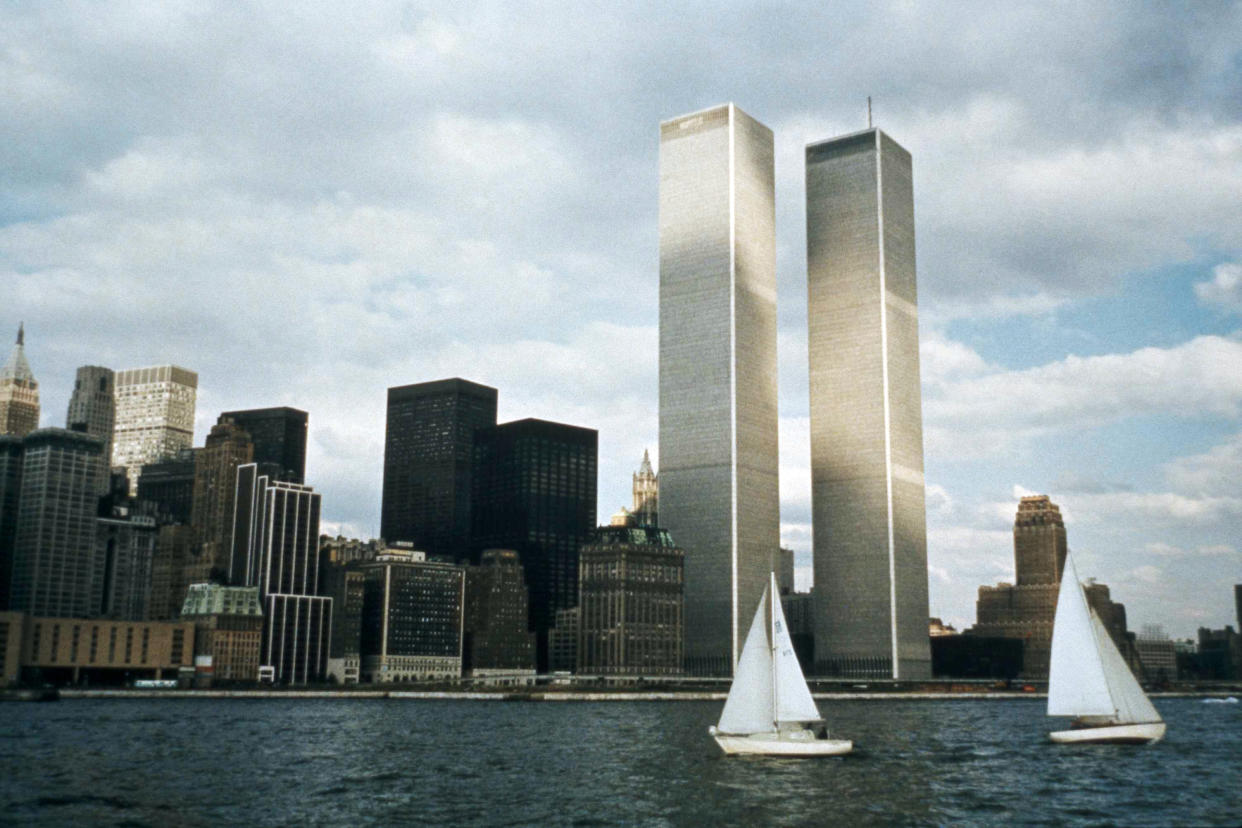
Construction of the twin towers began in August 1966, four months before I was born. Remarkably, the ribbon-cutting ceremony marking its completion was held a little more than six years later, on April 4, 1973. The demolition of the 110-story buildings, on the other hand, took just an hour and 42 minutes from the time American Airlines Flight 11 collided with the face of the north tower at 8:46 a.m., punching a gash through floors 93 to 99. United Airlines Flight 175 followed at 9:03 a.m., hitting the south tower between floors 77 and 85. If you lived in New York that day, those times and numbers are stamped on your memory. That obsessive cataloging was a way to help make sense of the ruthlessly efficient act of asymmetric warfare on both human life and the structure regarded — with the possible exception of the New York Stock Exchange Building a few blocks away — as the most recognizable physical embodiment of American capitalism.
The long-term repercussions of the disaster, many of which are still with us today, have been less easy to quantify — from the wars, government departments and the surveillance state that were started because of it, to the hastily discarded judicial norms and civil liberties. It’s not an exaggeration to say the attack transformed the world, but the physical destruction of the buildings — because of the enormity of the event — demanded to be continually replayed.
In 1971, the twin towers had become the world’s tallest, surpassing the Empire State Building, which had held that distinction since 1931. A few months before the Trade Center’s coronation, my family and I were living in Fairfield, Conn., a well-to-do bedroom community on Long Island Sound, a stop on the New Haven Railroad train line whose terminus — an hour and 35 minutes south and west — was Grand Central Terminal. We’d moved to the East Coast from the city of my birth, Fort Wayne, Ind., in 1968, when the company my father worked for, North American Van Lines, was bought by PepsiCo, the fast-growing soda and snack food competitor to Coca-Cola, and he was reassigned. As its calling card to show the world that it was here to stay, PepsiCo hired the acclaimed architecture firm Skidmore, Owings & Merrill to design its world headquarters at the corner of Park Avenue and 59th Street. Conceived by Gordon Bunshaft and Natalie de Blois, the Pepsi-Cola Corporation World Headquarters is an airy, modernist, 13-story aluminum and glass box that stood in stark contrast to the heavy, ornate stone and brick structures that defined Park Avenue (the sole exception being Lever House, another Bunshaft-de Blois design finished in 1952). Replacing walls with panes of glass, the new Pepsi headquarters invited the outside world into the building and all but erased the external workplace border for the employees inside it. The idea somehow made sense in a city where people were accustomed to being on public display, and when it was finished in 1960, the Municipal Art Society named it “Building of the Year.”

My father, however, didn’t work at the impossibly glamorous address that had heralded a new direction for New York architecture and later served as an inspiration for the writers of “Mad Men.” While he traveled there a few times a month, he was instead tasked with helping the company relocate its headquarters to a much less inspiring, sprawling, newly built 450,000-square-foot office complex designed by Edward Durrell Stone and set on a former polo field in Purchase, N.Y. Having quickly outgrown its splashy Park Avenue digs, PepsiCo joined the likes of IBM, Union Carbide and other corporate giants who abandoned the city for the suburbs. “A world of utter blandness,” New York Times architecture critic Paul Goldberger wrote in his review of the newly unveiled PepsiCo world headquarters in Purchase in 1970.
I have no memories of either headquarters that I can confidently say date back to the two years we lived in Fairfield, nor of the World Trade as it inched closer to overtaking the Empire State Building. Still just 3, I was on the precipice of long-term memory when PepsiCo purchased Wilson Sporting Goods and transferred my father to a job in suburban Chicago, uprooting us once more.
Unlike the Empire State Building’s 40-year reign as the world’s tallest skyscraper, the World Trade Center’s lasted just two. In 1973, the Sears Tower in Chicago grew to 1,450 feet, edging out the north tower’s 1,369 feet and the south tower’s 1,362. For most of my childhood, I grew up a 50-minute train ride from the new tallest building in the world, where my mother worked on the 58th floor as a corporate lawyer for Bank of America. I’d sometimes accompany her to the office on weekends, staring at the robot-like, matte black colossus as it seemed to march toward us with each axle rotation of the Chicago North Western Railway train wheels.

The Sears Tower was designed by architect Bruce Graham and structural engineer Fazlur Rahman Khan, a partner at Skidmore, Owings & Merrill who was born in what is now Bangladesh and came to the United States in 1952 on a Fulbright scholarship. At the University of Illinois, Khan earned a master’s degree in structural engineering and a second in theoretical and applied mathematics. After settling in Chicago, a city whose skyscrapers dazzled him, he embarked on a career that would revolutionize the modern skyline and earn him the nickname “the Einstein of structural engineering.” His most important advance was the “tube system” design, which cut down on the amount of steel needed to build skyscrapers without, it was said, sacrificing stability. That was especially important in the so-called “windy city,” and he first used the design on the John Hancock Center, the second-tallest skyscraper in the world when it was finished in 1969. Khan’s tube system advancement was then incorporated into architect Minoru Yamasaki’s design for the World Trade Center, before being used again for the Sears Tower.
“I put myself in the place of a whole building, feeling every part,” Khan said in an interview with Engineering News-Record. “In my mind I visualize the stresses and twisting a building undergoes.”
Khan’s high-profile projects had brought him to the attention of the Saudi royal family, who, by the 1970s, had embarked on a building boom that would modernize the architecture of the oil-rich, desert nation. In 1975, a year after the Organization of Petroleum Exporting Countries had asserted its global status as an energy bully and finally lifted an embargo on oil exports to the U.S., Khan was chosen to design the Hajj Terminal at King Abdulaziz International Airport in city of Jeddah, construction of which was completed in 1981. The old-meets-new final result was an open-air space that resembles a bedouin tent encampment, with gracefully sloping, retractable fabric roofs, where over a million pilgrims to the kingdom pass through each year on their pilgrimage to Mecca. Innovative in that it feels like the whole place might be packed up at a moment’s notice, the Hajj Terminal seems the antithesis to Khan’s tube skyscrapers, especially the imposing Sears Tower.
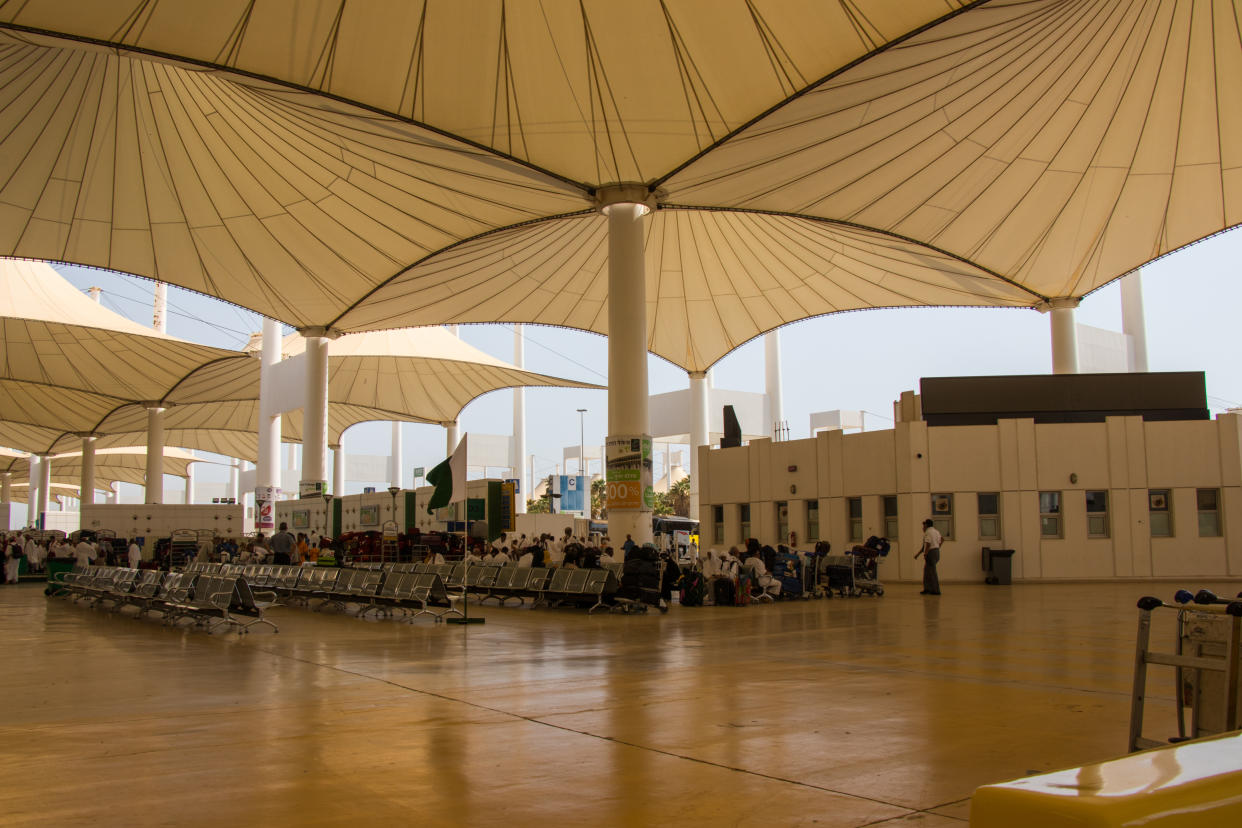
My own childhood memories of the Sears Tower reflect a mixture of emotions. Like a strict yet dependable father figure, I saw it as helping provide for our family, like a strict yet dependable father figure, giving my mother a place to go to collect her salary. On the other hand, the building gave off a decidedly menacing impression — a stiffness that seemed intent on crushing all that was small and artful. Its absence of decorative flourishes didn’t convey anything particularly human, or at least not the kind of human I hoped to become. Instead, it was just one right angle after the next — nine rectangular, slapped-together sections served a function that had nothing to do with aesthetic pleasure. Suffice it to say it would never win an award from an art society. Yet for a city built on a swamp, and one that had always suffered from a deep New York inferiority complex, claiming the world’s tallest building gave Chicago something to be first at, and I was proud my mother worked there. The retail giant Sears, Roebuck and Company commissioned the skyscraper in 1969 to serve as the headquarters for its 350,000 employees. But its massive, boxy utility would fare better than the company, which filed for bankruptcy in 2018 thanks to the rise of discount competitors like Walmart. In 2009, without ceremony, Khan’s behemoth was renamed the Willis Tower after being purchased by the insurance broker Willis Group Holdings.
Manifest entropy
Following my parents’ messy divorce in 1982, my mother and I moved from Chicago to San Francisco, where she’d put in for a transfer. Her new office was located in the Bank of America Center, a 52-story office tower also designed by Skidmore, Owings & Merrill as — what else? — the bank’s world headquarters. More important to me was whether it was the tallest building in San Francisco, and if you measured it in terms of the number of floors, the answer was yes. But if you counted the tip of the Transamerica Pyramid, which became the world headquarters for the Transamerica Corporation when it was finished in 1972, no. Though the insurance company’s pyramid measures 74 feet taller than the bank building, I remember my mother’s co-workers boasting that she’d gone from the tallest building in the world to the tallest one in San Francisco as though no asterisk was necessary.
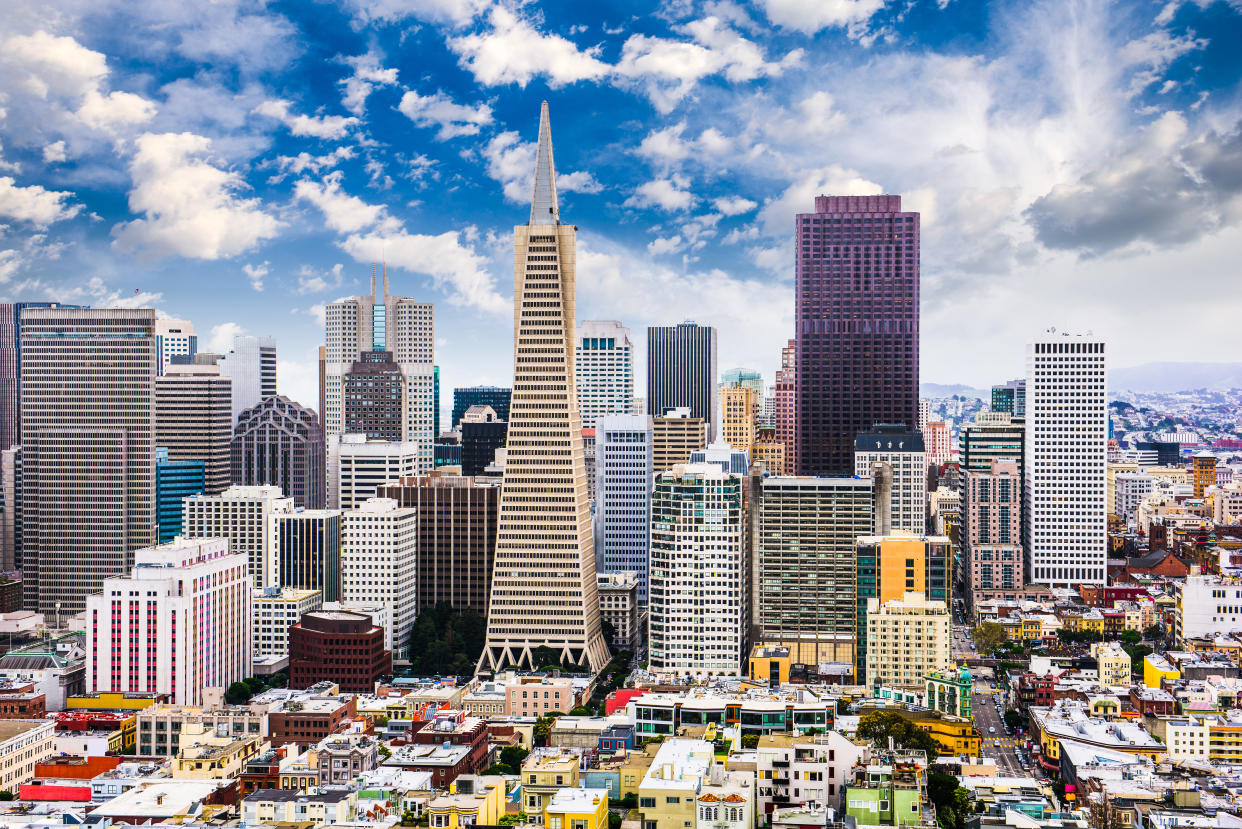
The Sears Tower held on to its tallest-building title until 1998, when it was surpassed by the Petronas Towers in Kuala Lumpur, Malaysia. Perhaps it was some consolation to Chicago that architect César Pelli had also incorporated Khan’s tube system on the project. When I interviewed Pelli in 2013 for an article on his design for San Francisco’s Salesforce Tower, which, upon its completion in 2018, bested both the Bank of America Center and the Transamerica Pyramid in height, he told me the obsession with the record books was overblown. “The numbers don’t interest me,” Pelli said. “What is important is that the building be visible above others.”
At 1,070 feet tall and 61 stories, the Salesforce Tower, which SF Gate editor Andrew Chamings called a “soulless monstrosity,” is indeed visible above all other buildings in the Bay Area, but few would argue it’s more distinctive than the 853-foot-tall Transamerica Pyramid. The same aesthetic discrepancy was often noted when people compared the Empire State Building and the World Trade Center. Few New Yorkers I knew expressed the same affinity for the World Trade Center. Like the Sears Tower, it felt more like a massive tower built of blocks, devoid of art. Even Pakistani terrorist Ramzi Yousef’s 1993 bomb attack failed to rally New Yorkers to its cause, perhaps because the damage to the structure occurred in an out-of-sight, underground parking garage and only six people lost their lives.

Though it was indeed once the tallest building in New York, the World Trade Center couldn’t really compete on an aesthetic basis with architectural gems like the Chrysler or Woolworth buildings, and I never once heard anyone say it was their favorite skyscraper. True, it reset Manhattan’s skyline and brought more life and focus to the southern tip of the island which, for decades, had been overshadowed by midtown. But like the Sears Tower, it did so in a bullying fashion — and who roots for bullies?
Yamasaki, the man who designed the twin towers, certainly did not. Throughout his childhood in Seattle, where he lived in a tenement in the Yesler Hill neighborhood, he was routinely bullied because of his Japanese ancestry. “I know from personal experience how prejudice and bigotry can affect one’s total thought process,” he wrote in his autobiography, “A Life in Architecture.” “The prejudice I experienced in Seattle hurt me deeply.” Raised by parents who had emigrated from Japan to the U.S. in search of work, he endured an upbringing peppered with racial slights and bigotry. After graduating with an undergraduate degree in architecture from the University of Washington, he moved to New York, where he earned a master’s degree from New York University. In 1938, his second job out of graduate school was with Shreve, Lamb and Harmon, the firm that had designed the Empire State Building. After the Japanese bombed Pearl Harbor, Yamasaki’s father was fired from his job at a shoe store, and his parents joined him in New York so as to avoid being sent to an internment camp. To prove his loyalty to the U.S., Yamasaki joined the Japanese American Committee for Democracy, in which he served as vice chairman alongside sculptor Isamu Noguchi. After the war, he moved to Detroit and was named design chief of Smith, Hinchman and Grylls, where Yamasaki made his mark. But even with his new title, Yamasaki was kept from buying property in predominantly white neighborhoods or joining all-white country clubs. His first big commission was a housing project in St. Louis, but due to the client’s limited budget, and under pressure to maximize space, he was forced to scrap his plans to incorporate green spaces throughout the development. When the Pruitt-Igoe complex was finished in 1955, it seemed to epitomize all that was dehumanizing about public housing. With 2,870 apartments shoehorned into 33 11-story brick towers that stretched for blocks, the racially segregated development became a magnet for urban problems. Seventeen years later, its demolition, which was filmed for posterity, was celebrated in St. Louis like a fireworks show.
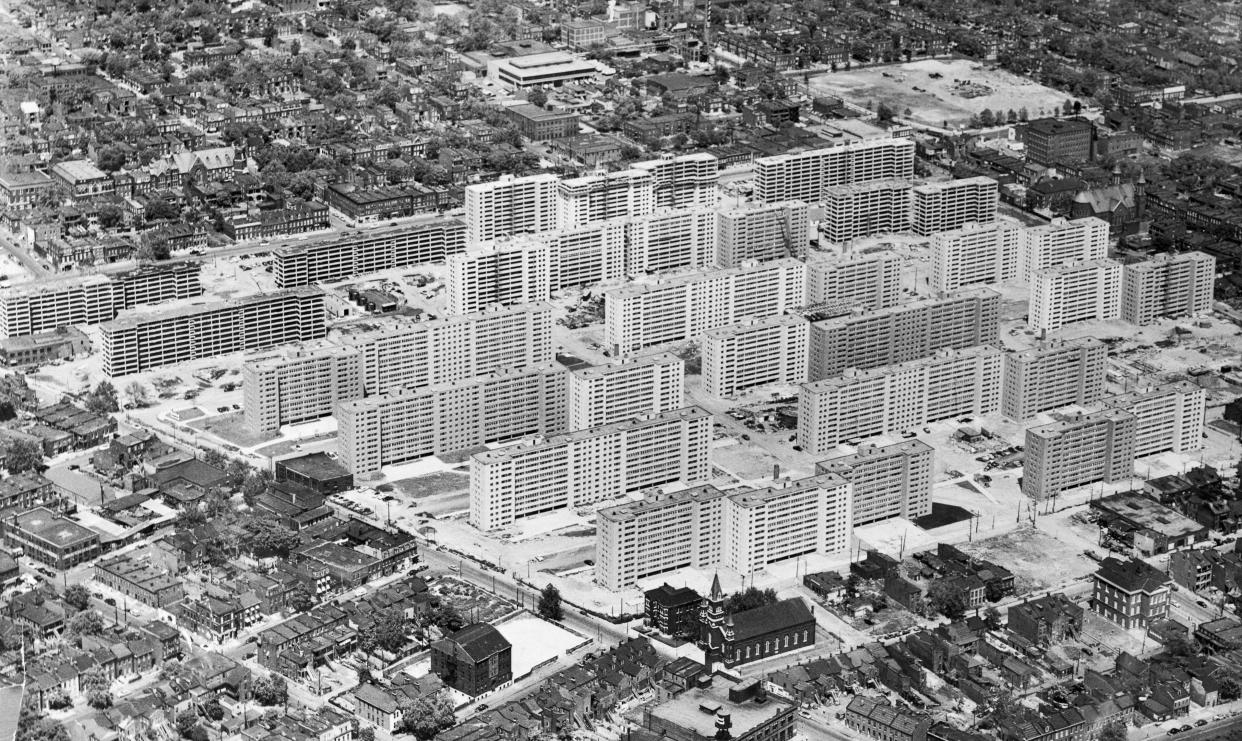
After the Pruitt-Igoe debacle, Yamasaki vowed never again to compromise his vision. A series of well-reviewed, high-profile commissions followed, and soon his work had attracted the attention of the Saudi royal family and the Binladen Group, the multinational construction conglomerate run by the brothers of 9/11 mastermind Osama bin Laden. In 1958, the Binladen Group commissioned Yamasaki to blend modern architecture with Islamic motifs for a new terminal at Saudi Arabia’s Dhahran International Airport. Islamic design elements already permeated Yamasaki’s portfolio — from his use of pointed arches to the delicate overlaid screen work (reminiscent of the Alhambra) that helped obscure functional elements. Unlike Bunshaft and de Blois, whose PepsiCo’s world headquarters erased the boundary between interior and exterior, Yamasaki suffered acute acrophobia and did his best to keep people from being tempted to stare out of the windows of his tall buildings.
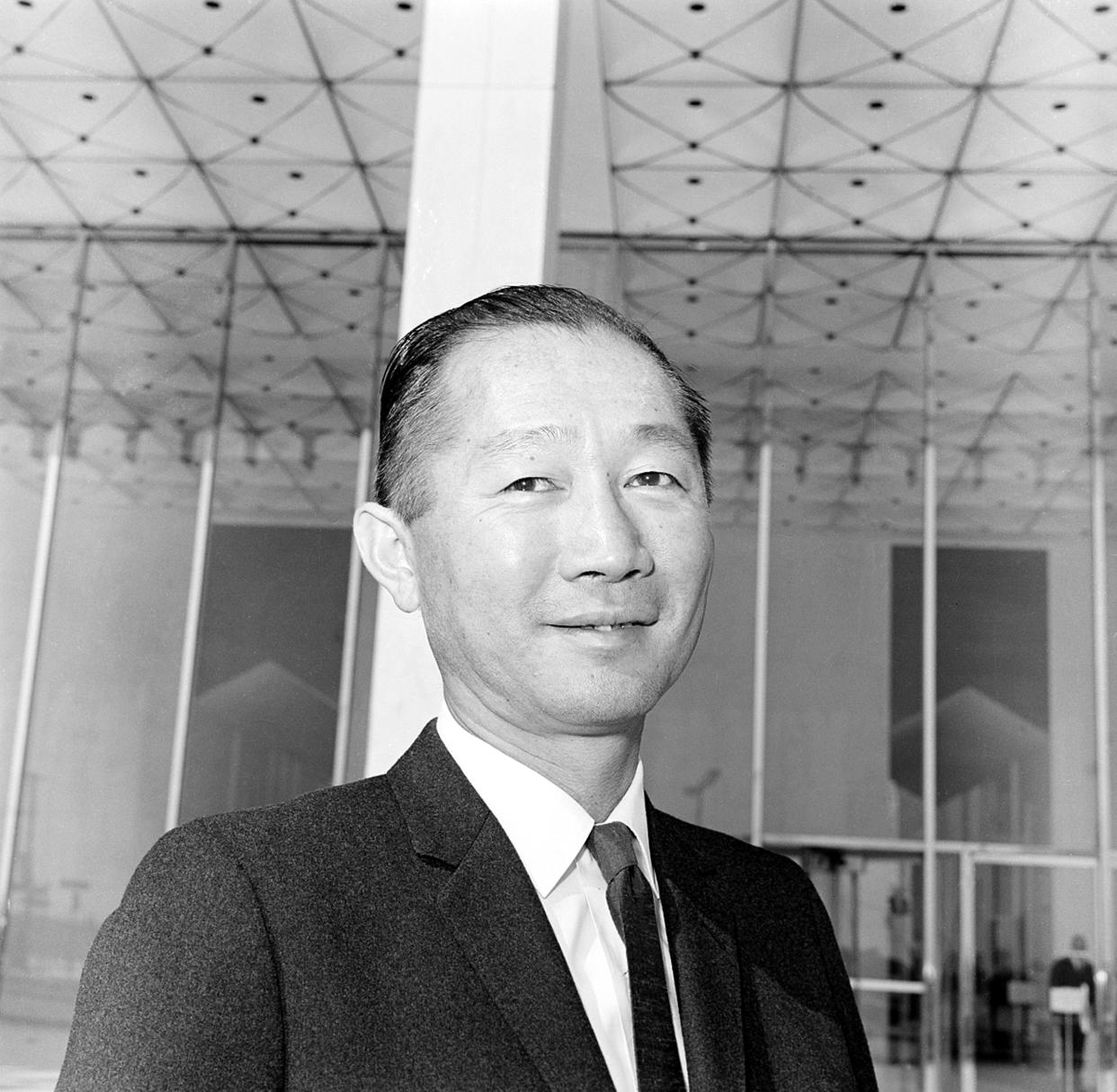
In 1962, a year after the Dhahran terminal was completed, Yamasaki submitted his plans for the World Trade Center, whose broad plaza he envisioned as “a mecca, a great relief from the narrow streets and sidewalks of the surrounding Wall Street area.” In fact, Yamasaki’s homage was even more literal. He based the plaza fronting the two towers on the one at Mecca’s Grand Mosque, Islam’s holiest site, whose pilgrims still arrive at Khan’s Hajj Terminal at King Abdulaziz International Airport in Jeddah.
The World Trade Center’s Islamic design influences were largely overshadowed, however, by the sheer immensity of the towers. In fact, thanks to their scale, most New Yorkers hated the buildings before they were even built.
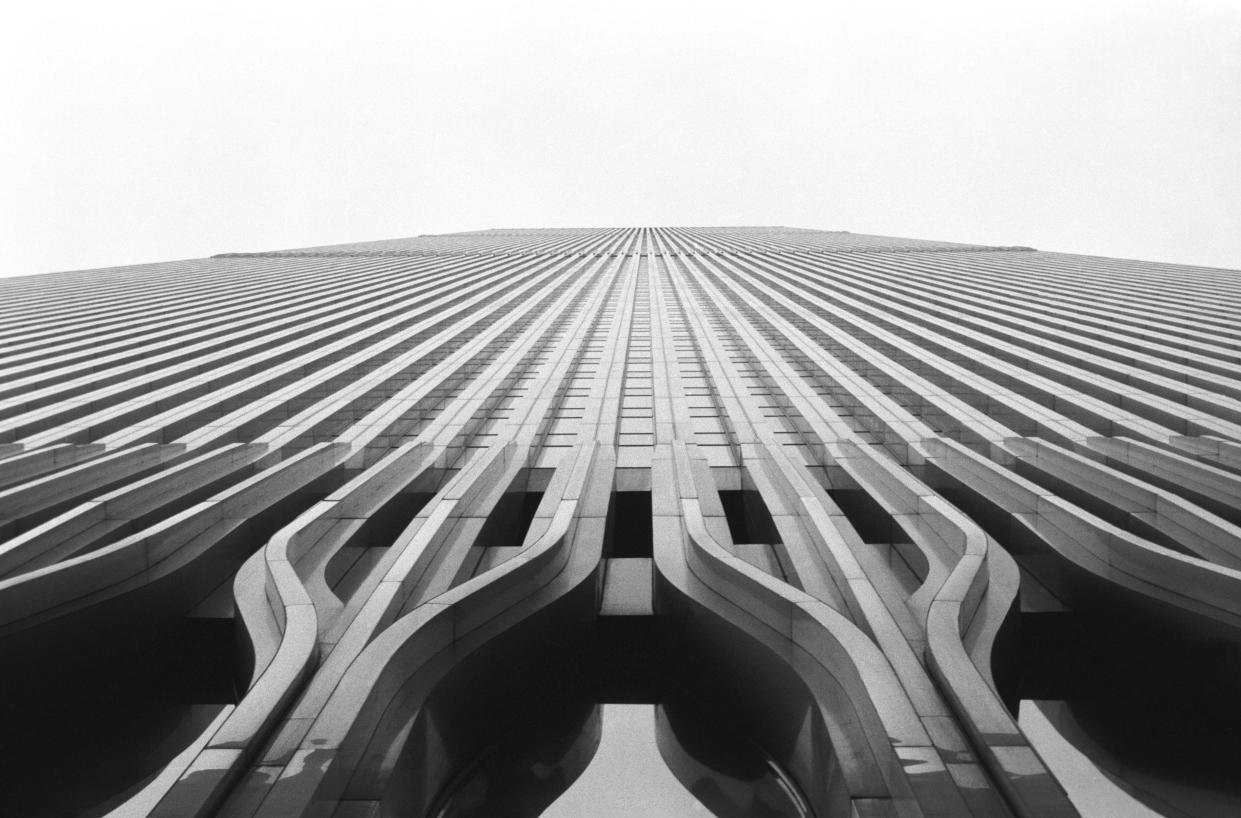
“These incredible giants just stand there, artless and dumb, without any relationship to anything, not even each other,” critic Wolf Von Eckhardt wrote in Harper’s in 1966 based on the designs for the project.
That antipathy never really faded. In 1985, a midtown observation deck worker told the New York Times that the World Trade Center best resembled little more than boxes in which to store true architectural gems like the Chrysler and the Empire State buildings. For most people, Yamasaki’s nod to Islamic design only came to light after learning that Osama, the renegade member of the bin Laden family, was the man behind the plot to destroy his towers.
Back to normal, again
When is it OK to return to a “normal way of life”? It’s a question that was asked following the 9/11 attacks and has been continually posed throughout the pandemic. In some ways, the mental toll taken by both events is similar: Each altered how we view America’s place in the world, crashed economies, brought cities to a halt and made us question the viability of tall buildings and congested spaces. Yet, while 9/11 was a discrete series of “loud explosions,” a spectacular, made-for-television event, the virus proved a much more efficient, silent killer, whose terrorism was not limited to a single day.
As traumatic as 9/11 was, largely due to the fact that it was a premeditated act of mass murder, 20 years on it feels somewhat puny in comparison to what COVID has done and will continue to do for years to come. The pandemic, you could say, bullied its way past the World Trade Center, relegating it to second-place as an era-defining disaster.
Of course, we can’t say how long it will be until the next catastrophe comes along and displaces the pandemic, or what the exact nature of that disaster will be. It may be climate change, a threat that promises to be greater in proportion to the pandemic than the pandemic was to 9/11. Yet inherent in the act of diving back into the pool of memory, of reliving all of the details of an event or time period, is the realization that even those indelible, life-changing events, if we are lucky enough to survive them, begin to decay the moment after we first live them. We can only carry so many heavy burdens for so long before we need to set them aside and give our weary back a rest. So too, the relentless rush toward the future and its yet-to-be-completed tall buildings often proves the stronger impulse than dwelling on the past.
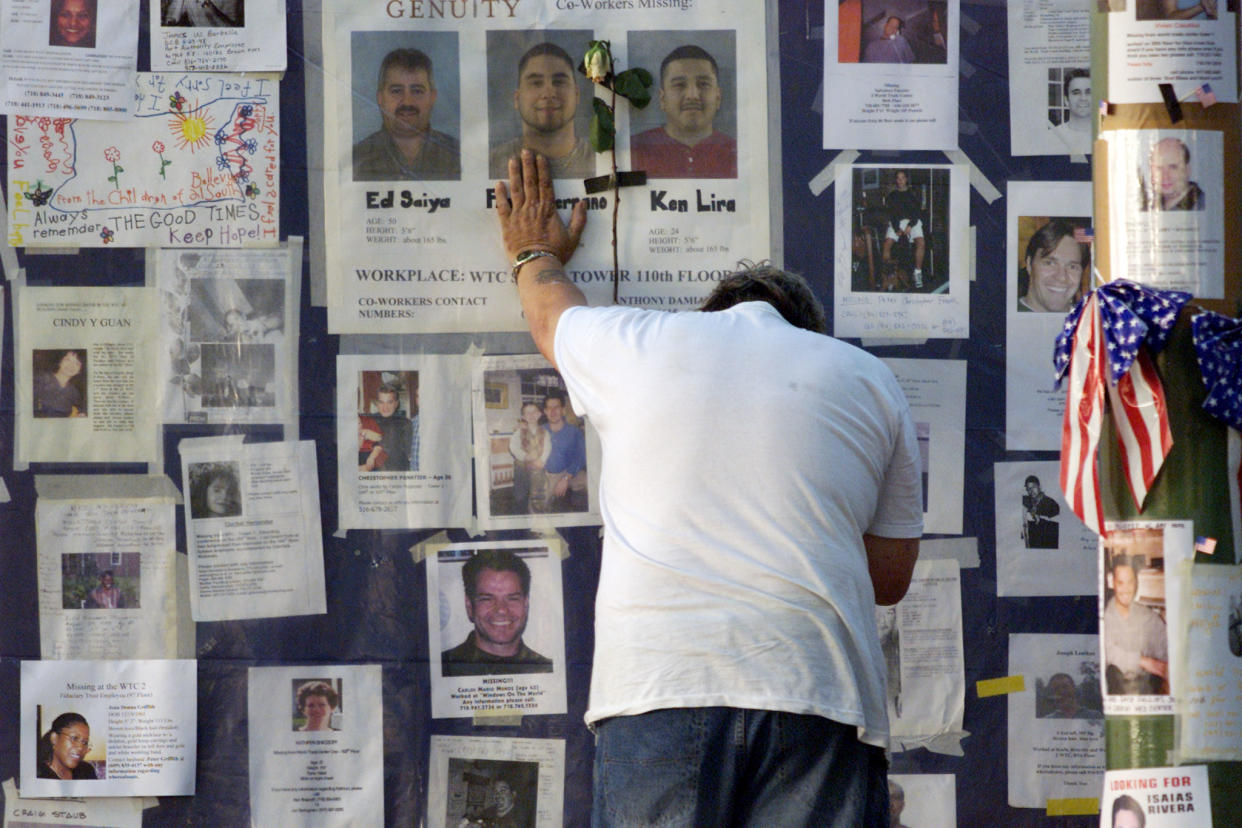
____
Read more from Yahoo News:



